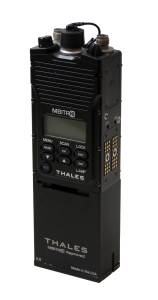Tactical radio systems in the recent past were single-purpose, narrowband solutions designed to address specific missions with a primary focus on secure voice communications. These solutions suitably provided critical voice communications in support of the “fighting doctrine” of the time.
Today’s geopolitical climate and the asymmetric nature of current military operations which include peace-keeping, counterinsurgency, and counterterrorism have rendered legacy communications solutions inadequate. Moreover, the Canadian Army’s future employment concepts based on adaptive, dispersed operations are challenging current capabilities and drive the need for increased communications range and capacity. New tactical radio requirements seek to embrace advances in telecommunications technologies and emphasize data-centric applications including text/SMS, situational awareness, command and control (C2) and video transport.
Current tactical radio solutions incorporate a software-defined radio architecture which eases the portability of multiple waveforms and more readily supports multiple applications. These multi-function radios provide legacy secure voice communications but also provide spectrally-efficient wideband mobile ad-hoc networking (MANET) waveforms that allow soldier’s to connect to the network from the tactical edge.
Being part of the tactical network, soldiers are able to share a sensor, C2 and navigation data thereby providing a more complete picture of the battlespace or Common Operational Picture (COP). This ability to more readily acquire information over the network and the improved situational awareness this provides ensures our armed forces retain the decisive advantage on the battlefield.
The Rifleman radio
The United States Army and its key allies (5-Eyes and others) are now looking to the Rifleman radio, a small and light single-channel radio to deliver the lower-tier tactical network to the individual soldier.
The Rifleman radio is designed to provide the individual soldier with secure voice communications and the ability to send messages, access mission-related applications and share soldier position location using embedded Global Positioning System (GPS) technology.

A key element of the army’s Nett Warrior system, the Rifleman radio integrates with a soldier-worn power and data management systems and an Android-based end-user device (EUD) which hosts mission-specific applications. Over 20,000 Rifleman radios have already been fielded with 10 Brigade Combat Teams (BCT’s) as part of Capability Sets 13 and 14.
The Nett Warrior system, integrated with the Rifleman radio, has ensured deployed forces have access to reliable digital communications and situational awareness improving mission effectiveness and force protection. Thales Defense & Security, Inc. (Thales) is proud to be one of two exclusive suppliers of the Rifleman radio to the U.S. Army.
The latest component, design and production technologies have allowed radio manufacturers to make large strides in smaller and lighter radio designs that incorporate expanded features and capabilities.
To cover a broad mission set, today’s soldiers are forced to carry a significant amount of equipment including sensors, armor, weapons, power systems, and communications devices.
Converging functionality into smaller, lighter, integrated and multi-function devices can dramatically reduce the soldier carry load. A good example of this is the modern fires team.
A typical forward observer (FO) may carry, as part of the standard mission kit, a standard narrowband handheld radio for communications with aircraft or supporting elements, a Rifleman radio for network connectivity, a ROVER video receiver, and a GPS receiver.
Including the cabling and power these devices require, the total weight can quickly exceed mission weight requirements.
The Thales MBITR2
Leveraging the latest technology, Thales has developed a multi-channel handheld radio that incorporates the functionality of all four of these communications devices into a single, two-pound, handheld radio that is approximately the same size as a standard traditional single-channel handheld. The Thales MBITR2 along with the full motion video mission module (FMV MM), significantly reduces the soldier carry load while maintaining full capability in a single integrated package.

The U.S. Army has embraced the concept of a two-channel handheld radio and is currently developing a new requirement based on this concept for its future Leader Radio. While product development is driven by U.S. requirements, the majority of these operational needs are relevant to the Canadian Army, bridging the communications gap between future mounted and dismounted forces.
Once again, pushing the boundaries of innovation, Thales’ MBITR2 achieves unmatched performance, typical of a larger and heavier Manpack Radio in a handheld form-factor.
With embedded GPS and running all traditional narrowband waveforms, including SINCGARS, HaveQuick II, and UHF SATCOM, while also simultaneously supporting the army’s wideband Soldier Radio Waveform, the MBITR2 is the first two-channel handheld on the market. The addition of the FMV MM as a third channel capable of receiving full motion video from, for example, an unmanned aerial system (UAS), the MBITR2 provides a significant increase in mission capability for the soldier in a significantly reduced form-factor.

The MBITR2 has been integrated both with U.S. Army Nett Warrior and Fires Warrior systems. It has undergone exhaustive testing and trials with operational Army and Special Operations Forces (SOF) units receiving glowing endorsements on its performance and capabilities.
Today’s tactical radio solutions provide expanded features, functions, and capabilities in a significantly reduced size and weight form-factor. Providing network access at the tactical edge, these new radios give the dismounted soldier enhanced situational awareness and improved mission effectiveness. Using open-standard interfaces, these new radio solutions are easily integrated into advanced soldier systems including sensors, C2, and power systems.
Adopting software-defined design standards, these new radios are also able to adapt to new waveforms and new features through software updates ensuring their long-term viability. Today’s smart radios ensure the technology we provide our armed forces keeps pace with the evolving mission and ensures the decisive advantage on the battlefield.

